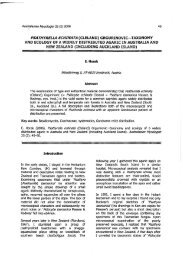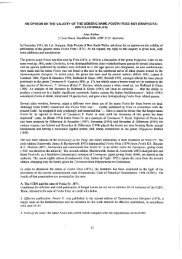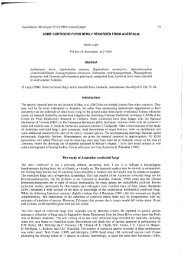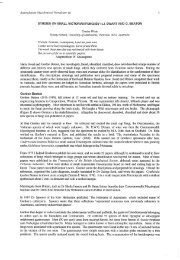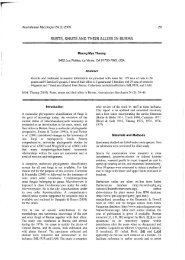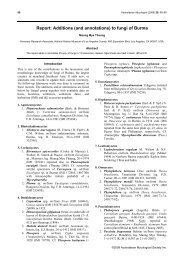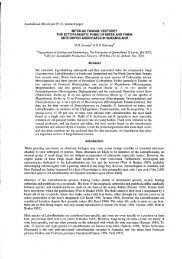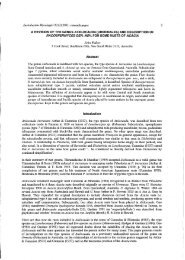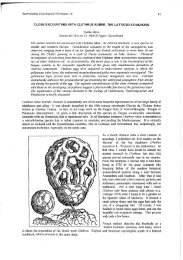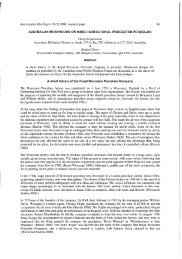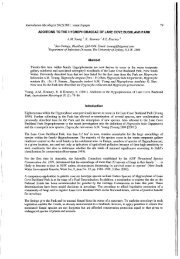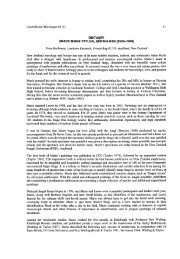WHY DON'T MORE BIRDS EAT MORE FUNGI? - The Australasian ...
WHY DON'T MORE BIRDS EAT MORE FUNGI? - The Australasian ...
WHY DON'T MORE BIRDS EAT MORE FUNGI? - The Australasian ...
Create successful ePaper yourself
Turn your PDF publications into a flip-book with our unique Google optimized e-Paper software.
<strong>WHY</strong> <strong>DON'T</strong> <strong>MORE</strong> <strong>BIRDS</strong> <strong>EAT</strong> <strong>MORE</strong> <strong>FUNGI</strong>?<br />
J.A. Simpson<br />
Forest Research and Development Division,<br />
State Forests of New South Wales, P. O. Box 100, Beecroft 2119.<br />
Only one species of bird in Australia, the southern cassowary Casuarius casuarius, is known to have fungi as a<br />
regular and significant part of the diet (Barker & Vestjens 1989a, b). Admittedly one has concerns about the<br />
reliablity of the mycological data in these books as 'mushrooms' and 'bracket fungi' are listed as ALGAE in<br />
Appendix 1 (Barker & Vestjens 1989a). Cassowaries eat fruit of many species of plants digesting only the<br />
pericarps and excreting the seeds whole. However, it is known they also eat bracket fungi, as these were found in<br />
the droppings throughout the year (Crome 1976). <strong>The</strong> fungi were not identified. It is likely cassowaries also eat<br />
species of Agaricales and Pezizales though they were not observed in droppings. Soft fleshy fungi would<br />
disintegrate in the gizzard and not be identifiable without examination of the spores in the faeces.<br />
Contrast that situation with the behaviour of the native vertebrates of Australia. Many small mammals (rodents<br />
and marsupials) and some larger ones, including grey kangaroos and swamp wallabies (Simpson unpublished),<br />
have macrofungi as a component of the diet. <strong>The</strong> significance of fungi in the diet varies with species but in some<br />
of the smaller mammals they are a major component. More than 100 different species of macrofungi,<br />
predominantly with hypogeous fruiting bodies, have been identified from faecal pellets from small mammals in<br />
Australia (Claridge & May 1994) and the number increases each year as new discoveries are reported.<br />
So why don't birds eat fungi? For many birds they would not be difficult to find or browse upon. One might<br />
expect species of emus (Dromidae) that feed on leaves, seeds and fruits of diverse plants to also feed on fungi<br />
such as agarics and puffballs. Adult Dromaius novaehollandiae swallowed immature basidiomata of species of<br />
Lycoperdon and Bovista presented to them near Canberra. Brush turkeys Alectura lathami swallowed<br />
basidiomata of Mycena sp. presented to them near Atherton. This suggests that species of Megapodiidae might<br />
opportunistically feed on macrofungi. Zwart (1973) working in Sherbrooke Forest near Melbourne, observed<br />
pilotbirds Pycnoptilusfloccosus, to 'feed rarely on small mushrooms'. <strong>The</strong>se ground feeding warblers live on the<br />
'moist leaf-strewn floor of dense forest' (Slater 1983) using their bills to find food under the litter (Zwart 1973).<br />
Again the fungi were not identified and the observation seems not to have been followed up. Superb lyrebirds<br />
Menura superba, scratch up large areas of forest floor in their search for invertebrates for food Slater 1983).<br />
Basidiomata of hypogeous fungi are often to be found in the scratchings of lyrebirds examined in late autumn<br />
and winter near Sydney and Goulburn. <strong>The</strong>ir presence is perhaps an indication that the birds do not eat fungi.<br />
However, the scratchings of small mammals also often include basidiomata that are inadvertently buried or<br />
pushed to one side in the urge to gorge on an abundant fruiting.<br />
One possible explanation for the absence of mycophagy amongst birds may be the kinds of sugars fungi<br />
accummulate. Most fruits are rich in short chain sugars such as glucose and fructose. Fungi tend to store<br />
trehalose or sugar alcohols. Are these compounds unpalatable or toxic to birds?<br />
<strong>The</strong> data of Barker & Vestjens (1989a, b) were obtained by examining the stomach contents of a large number of<br />
birds collected and studied over a period of almost three decades. It is surprising that only one species of bird<br />
was recorded as having ?mould in the stomach {i.e. oesophagus, crop or gizzard) namely the white plumed<br />
honeyeater Lichenostomus penicillatus. Foliage infested with sap sucking insects commonly supports also a<br />
large population of sooty moulds. It was surprising that sooty mould was not recorded from the stomachs of bell<br />
miners Manorina melanophrys. <strong>The</strong>se communal birds appear to help maintain large populations of Psylloidea<br />
on living leaves in quite extensive patches of eucalypts. Commonly the insect colonies develop sooty mould<br />
colonies about them. Do birds avoid insects with sooty mould? Does sooty mould afford protection from<br />
predatory birds?<br />
Many insects are mycophagous (Kukor & Martin 1987, Lawrence & Milner 1996). Decomposing fungi of all<br />
kinds, putrescent and perennial, commonly contain large populations of larvae and adult invertebrates. Yet this<br />
large resource seems not to be directly exploited by birds. Rather than breaking basidiomata or ascomata apart to<br />
obtain the invertebrates birds seem to prefer to wait until they emerge and disperse. Is this an accurate<br />
observation? If not then why do birds ignore this source of readily available food? Further studies may indicate<br />
that Australian birds are not as mycophobic as the literature currently suggests.
References<br />
Barker, R.D. & Vestjens, W.J.M. (1989a). <strong>The</strong> Food of Australian Birds 1. Non-Passerines. CSIRO Melbourne,<br />
Australia.<br />
Barker, R.D. & Vestjens, W.J.M. (1989b). <strong>The</strong> Food of Australian Birds 2. Passerines. CSIRO Melbourne,<br />
Australia.<br />
Claridge, A.W. & May, T.W. (1994). A review of mycophagy in Australian mammals. Australian Journal of<br />
Ecology 19:251-275.<br />
Crome, F.H.J. (1976). Some observations on the biology of the cassowary in northern Queensland. Emu 76: 8-<br />
14.<br />
Kukor, J.J. & Martin, M.M. (1987). Nutritional ecology of fungus-feeding arthropods, pp. 791—814. In Slansky,<br />
F. & Rodriguez, J.G. (eds). Nutritional Ecology of Insects, Mites, Spiders, and related Invertebrates.<br />
John Wiley & Sons, New York.<br />
Lawrence, J.F. & Milner, R.J. (1996). Associations between Arthropods and Fungi. Fungi of Australia IB: 137—<br />
202.<br />
Slater, P. (1983). A field guide to Australian Birds. Volume 2 Passerines. Rigby Publishers, Adelaide.<br />
Zwart, M.H. (1973). Breeding and behaviour of pilotbirds. Emu 73: 124-128.<br />
A FUNGUS AS THE CAUSE OF FROG DECLINES<br />
J. A. Simpson<br />
Forest Research & Development Division,<br />
State Forests of New South Wales, P. O. Box 100, Beecroft 2119<br />
In recent decades it has been observed that populations of frogs and other amphibians have declined dramatically<br />
in parts of Australia, North America and Europe. Numerous causes for this phenomenon have been suggested<br />
including increased solar radiation resulting from destruction of the ozone layer and invasion of rainforests in<br />
Australia by camphor laurel trees. None of those claims has been substantiated.<br />
Recently a new species of Chytridiales has been found on sick and dying amphibians in Queensland, Panama and<br />
the United States of America (Berger et al. 1998, Pessier et al. 1999). Under experimental conditions the fungus<br />
has been observed to be a virulent pathogen able to infect and cause thickening of the keratised epidermis of<br />
living adult anurans (Berger et al. 1998). This can impair cutaneous respiration and osmoregulation; the disease<br />
is often fatal (Berger et al. 1998). <strong>The</strong> fungus can infect tadpoles but does not cause mortality because tadpoles<br />
have only localised areas of keratised epidermis. This is apparently the first report of parasitism of a vertebrate<br />
by a species of Chytridiomycota.<br />
In early conference reports it was suggested the amphibian parasite was a species of Perkinsus (Protoctista) but<br />
ultrastructural and DNA sequence data have shown this to be not the case (Berger et al. 1998). <strong>The</strong> frog chytrid,<br />
which in some respects resembles a species of Rhizophydium, is to be described as a new species and genus<br />
(Longcore 1998).<br />
<strong>The</strong> geographic origin of the frog chytrid and the mode of international dispersal are not yet known. Berger et al.<br />
(1998) suggested it could be an introduced pathogen spreading through naive populations or it could be a<br />
widespread organism that has become more virulent because of unidentified amphibian stress factors. If the frog<br />
chytrid is an exotic to Australia it will be interesting to see if it was introduced on imported amphibians for the<br />
aquarium trade or if it came in on the collecting gear of students of amphibians. This has the attributes to be a<br />
Challenging case for those interested in quarantine risk analysis.<br />
References<br />
Berger, L., Speare, R., Daszak, P., Green, D.E., Cunningham, A.A., Goggin, C.L., Slocombe, R., Ragan, M.A.,<br />
Hyatt, A.D., McDonald, K.R., Hines, H.B., Lips, K.R., Marantelli, G & Parkes, H. (1998).<br />
Chytridiomycosis causes amphibian mortality associated with population declines in the rain forests of<br />
Australia and Central America. Proceedings of the National Academy of Science U.S.A 95: 9031—9036.<br />
Longcore, J.E. (1998). Chytrids: a teaching note. Inoculum 49 (5): 5.<br />
Pessier, A.P., Nichols, D.K., Longcore, J.E. & Fuller, M.S. (1999). Cutaneous chytridiomycosis in poison dart<br />
frogs (Dendrobates sp.) and White's tree frogs (Litoria caerulea). Journal of Veterinary Diagnostic<br />
Investigation, (in press)



